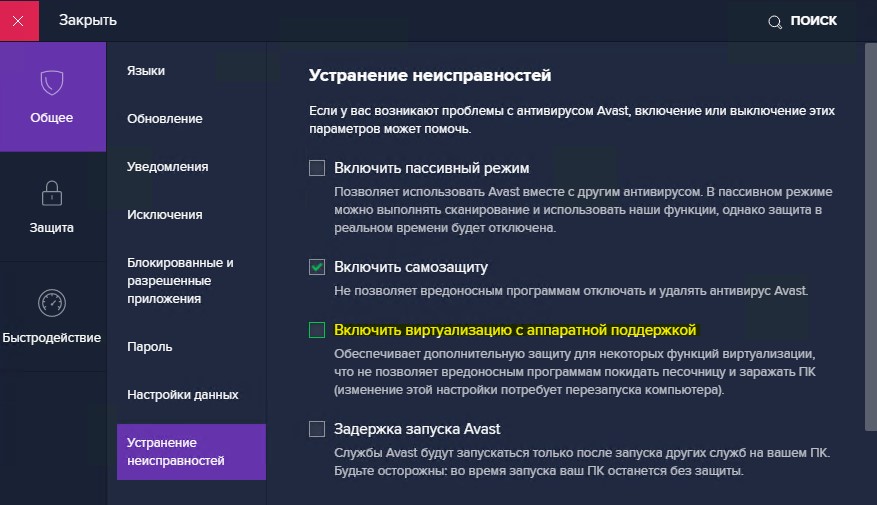код ошибки vtx disabled
Ошибка VT-x is not available (verr_vmx_no_vmx) в Windows 10
Ошибка vt-x is not available (verr_vmx_no_vmx) появляется, когда пользователь запускает виртуальные машины при помощи VirtualBox на Windows 10. Виновником данной ошибки могут быть несколько причин: не включена виртуализация в BIOS, включен Hyper-V, включена изоляция ядра, Avast может отключить виртуализацию.
1. Отключить Hyper-V
Эта самая распространенная ошибка, когда пользователь при включенном Hyper-V использует и VirtualBox или любую другую стороннюю программу как Docker. Дело в том, что, если включена встроенная виртуальная машина Hyper-V, то она отключает виртуализацю для VirtualBox.
Запустите командную строку от имени администратора и введите ниже команды:
Перезагрузите ПК и посмотрите появляется ли ошибка vt-x is not available (verr_vmx_no_vmx) при запуске виртуальных машин.
2. Avast
Если у вас стоит сторонний антивирус как Avast, то вам ну;но выключить в параметрах антивируса «Включить виртуализацию с аппаратной поддержкой«.
3. Изоляция ядра
Изоляция ядра это параметр безопасности встроенного антивируса в Windopws 10. Известно что включенная изоляция ядра конфликтует и создает много проблем связанных с виртулизацией.
Откройте защитник Windows и перейдите «Безопасность устройства» > «Сведения об изоляции ядра» > и убедитесь, что параметр «Целостность памяти» выключена. Перезагрузите компьютер, чтобы применить изменения.
Если у вас целостность памяти было включена и вы не можете отключить, то обратитесь к этому руководству , последнему способу.
4. Виртуализация в BIOS
Если выше способы не помогли исправить ошибку vt-x is not available (verr vmx no vmx) при запуске виртуальных машин в Windows 10, то скорее всего виртуализация отключена в BIOS на уровне ядра процессора и её нужно включить.
Зайдите в BIOS или UEFI и включите параметр виртуализации. Так как BIOS у всех разный и параметр может называться по разному, то советую воспользоваться Google или Yandex картинками. К примеру, у вас материнская плата Asus, то просто напишите в поиске «Как включить виртуализацю в BIOS Asus«.
VT-x отключен в BIOS для обоих режимов процессора (VERR_VMX_MSR_ALL_VMX_DISABLED)
Загрузили Android-плеер Xamarin и с помощью → next → progress installed Virtual Box.
Когда я попытался запустить эмулятор, я получил
а деталь ошибки в Oracle Vm Virtualbox –
Как я могу это исправить?
Я нашел решение своей проблемы, поместил некоторые изображения, чтобы помочь другим, спасибо
здесь
Это проблема с ОЗУ. Документация самоочевидна:
Вы пытаетесь выделить VM на 3 ГБ ОЗУ. Это требует: (a) 64-битная хост-система; и (б) истинный аппаратный проход, т.е. VT-x.
Быстрое решение
Выделите менее 3 ГБ для виртуальной машины.
Полное решение
Включение/выключение PAE/NX не помогло мне. Мне просто нужно было включить виртуализацию на моем компьютере. Я работал над HP Compaq 8200 и выполнил следующие шаги, чтобы включить виртуализацию. Если вы работаете на другом компьютере, вам, вероятно, просто нужно посмотреть, как включить виртуализацию на вашем компьютере. Ниже приведенные ниже шаги для HP Compaq 8200 (или аналогичных) скопированы из комментария, опубликованного пользователем qqdmax5 на дискуссионной панели Hp здесь.
Для запуска машин VM VM Virtual Machine/VMware на 64-битном хосте необходимо включить технологию виртуализации (VTx) и технологию виртуализации Directed I/O (VTd).
Обычно эти настройки отключены на уровне BIOS.
Чтобы включить VTx и VTd, вы должны изменить соответствующие настройки в BIOS.
Вот пример, как это сделать для HP Compaq 8200 или аналогичного ПК:
Существует также некоторое обсуждение этого вопроса на askubuntu.
В Virtual Box “Настройки” > “Системные настройки” > “Процессор” > Включите опцию PAE/NX. Он разрешил мою проблему.
У меня была эта проблема при попытке запустить 32-разрядную ОС с выделенным для нее объемом более 3584 МБ ОЗУ. Установка гостевой ОС RAM на 3584 МБ и менее помогла.
Но я закончил просто включение флага в BIOS тем не менее.
Выполните следующие действия в диспетчере виртуальных виртуальных машин Oracle:
Чтобы проверить, запустите виртуальное устройство из виртуальной машины VM VirtualBox. Если все пошло хорошо, устройство загрузится.
Закройте это устройство и откройте его из Genymotion.
включить PAE/NX в конфигурацию сети виртуальных сетей
Мой BIOS VT-X был включен, но мне пришлось выключить PAE/NX, чтобы запустить VM.
Для последней версии Windows 10 (материнская плата/процессор HP и Intel),
Выполните следующие шаги, начиная с:
F10 для сохранения и выхода
Если вы на 32-битной машине не разрешаете больше 3584 МБ ОЗУ и она будет работать.
Мне пришлось выключить PAE/NX, а затем вернуться к… voila!!
Просто проверьте, сколько процессоров вы выделяете. С одним процессором вам не нужно играть с вашей биозой.
Для Ubuntu на HP (процессоры Intel),
Нажмите F10 при загрузке системы, она войдет в режим настройки системы.
Вы найдете вкладки сверху, как Main, Security, Advanced.
Зайдите в Advanced >> и нажмите на Настройки системы.
Установите флажки Включить технологию виртуализации (VTx) и Виртуальный ввод-вывод по технологии виртуализации (VTd).
Вернуться на главную, нажмите сохранить изменения и выйти.
Убедитесь, что виртуализация включена в вашем BIOS.
Fix: VT-X is Disabled in the Bios for All CPU Modes (Verr_Vmx_Msr_All_Vmx_Disabled)
Virtual machines (or VMs, as they are commonly referred to as) are astounding things. You can use a virtualization program to create a virtual machine, and on a virtual machine, you can run an entire virtual computer – complete with its very own Operating System – in a window on your current system. Virtual machines are commonly used to try out different Operating Systems, test programs in a sandbox environment and to experiment with the features of a system without worrying about any repercussions. For virtualization programs such as VMware and Hyper-V to work on a computer, though, they need access to the hardware acceleration technology that comes built into almost all CPUs in this day and age.
The hardware acceleration technology built into Intel CPUs is known as Intel VT-X hardware acceleration and that in AMD CPUs is known as AMD-V, whereas other CPU manufacturers (such as AMD) bless their processors with different hardware acceleration technologies. In many cases, VT-X is, by default, disabled on Intel processors. Trying to run a virtual machine on a computer that has such a processor results in the virtualization app being used spitting out an error message that usually informs the user that the program needs hardware acceleration to function, but it looks as though they currently have the technology disabled.
Intel’s VT-X hardware acceleration technology can indeed be enabled and disabled at will, and all a user needs to do in order to enable or disable it is access to their computer’s BIOS or UEFI settings. This is true in the case of all of the iterations of Windows that are currently supported by Microsoft, including Windows 10 – the latest and greatest in a long line of Windows Operating Systems.
The process you need to go through in order to enable VT-X hardware acceleration on a computer varies slightly depending on whether the computer in question has a BIOS or is a UEFI computer. Computers that came with a version of Windows older than Windows 8 out of the box will almost always have a BIOS, whereas computers that came with Windows 8 or later out of the box are likely to have UEFI settings instead. The industry’s standard for computers is gradually but surely moving towards UEFI, so the newer a computer is, the likelier it is to have UEFI settings. To enable VT-X on a Windows 10 computer, you need to follow the steps mentioned below.

What is causing the VT-X is Disabled in the Bios for All CPU Modes (Verr_Vmx_Msr_All_Vmx_Disabled)?
We investigated this particular error message by looking at various user report and the solution that they used to fix the issue. This problem is not easy to fix since it occurs on both Windows and Linux. However, we managed to spot a few common scenarios that are known to trigger this particular error message:
If you’re currently struggling to resolve this particular issue, this article will provide you with a list of quality troubleshooting steps. Below you have a collection of methods that other users in a similar situation have followed to get the issue resolved.
For the best results, follow the methods below in the order that they are presented until you encounter a fix that resolves the problem in your particular scenario.
Method 1: Verify whether your CPU supports VT-X/ AMD-V
Before you try anything else, let’s make sure that the system that you’re encountering the issue on is designed to accommodate VT-X (Intel) or AMD-V (AMD). If your CPU is old enough, it’s possible that it was simply not designed to support virtualization.
There are several methods that you can follow to verify if your CPU supports virtualization, but we’re going to take the easy route. SecurAble is a freeware that will help us determine your processor features and tell us whether virtualization is achievable.
Here’s a quick guide on downloading and using SecurAble to see whether your CPU supports virtualization:
If you confirm that hardware virtualization is supported, you can follow the methods below in order knowing that one of them will resolve the VT-X is Disabled in the Bios for All CPU Modes (Verr_Vmx_Msr_All_Vmx_Disabled) error.
In the event that the test showed that your machine does not support hardware virtualization, you will not be able to resolve the issue using the methods below.
Method 2: Enable Virtualization Technology (VTX) from BIOS
If you’re encountering the issue on a 64-bit host, keep in mind that you’ll likely need to enable Virtualization Technology (VTx) from your BIOS settings. On some motherboards, you will also need to enable Virtualization Technology Directed I/O (VTd)
Some motherboards come with this option enabled by default, but manual user intervention or 3rd party interference might disable it.
Note: Windows Hyper V can also be responsible from disabling VT-x on your computer.
Keep in mind that the exact menu options that involve the enabling VT-X or AMD-V will be different according to your motherboard. But in general, the steps are roughly the same. Here’s a quick guide on making sure that VT-X or AMD-V is enabled in your BIOS settings:
On a Computer with UEFI
Once you are inside your computer’s UEFI settings or BIOS, you can actually get to work on locating the option for VT-X hardware acceleration technology and enabling the feature. Simply look around in all of the BIOS’ or UEFI settings’ tabs and sections for an option for VT-X hardware acceleration – this option will be labeled something along the lines of “Intel VT-X“, “Intel Virtualization Technology“, “Virtualization Extensions” or “Vanderpool“.In most cases, this option is found under a Processor sub-menu of a Chipset, Northbridge, Advanced Chipset Control, or Advanced CPU Configuration main menu or tab.
Once you have located the option for VT-X hardware acceleration within your computer’s BIOS or UEFI settings, simply turn it on and VT-X hardware acceleration will be enabled. Be sure to save your changes and then exit the BIOS or UEFI settings (precise instructions for which you will be able to find inscribed somewhere on the BIOS or UEFI settings screen). When you get out of the BIOS or UEFI settings of your computer, your computer will boot up like it normally does.
Method 3: Enabling or Disabling PAE/NX from VirtualBox Manager
Several users struggling to resolve the same error message have reported that the issue was resolved entirely after they juggled with the Virtual device settings and enabled PAE/NX from the Settings menu. Some of them fixed their issue by Disabling PAE/NX from the Settings menu. You can check to see which one works the best for you.
This option determines whether PAE (Physical Adress Extension) and NX capabilities of the host CPU will be exposed to the virtual machine.
Although this is not guaranteed to work, it’s typically reported to resolve the issue on 64-bit computers that are confirmed to support hardware virtualization. Here’s a quick guide on enabling PAE/NX from Oracle VM VirtualBox:
If you’re still seeing the VT-X is Disabled in the Bios for All CPU Modes (Verr_Vmx_Msr_All_Vmx_Disabled) error when attempting to start the virtual machine, keep in mind that some people reported they had this option enabled and disabling it fixed the error for them. We highly recommend you to try turning it off if it was already enabled. Now If that doesn’t help you as well, you can move to the next method.
Method 4: Increasing the RAM size
Several users encountering the same issue have reported that the issue was resolved after they increased the allocated RAM size and started the virtual machine again.
Update: Some users have reported that in their case, the fix involved actually reducing the allocated RAM size.
If the methods above have proven to be ineffective, follow the steps below to either increase or decrease the RAM size:
Method 5: Preventing 3rd party antivirus from interfering with hardware virtualization
An unlikely culprit but one that has been identified to cause the issue times and times again is the 3rd party antivirus solution. Several users encountering the same issue have reported that in their case, Avast (or another 3rd party AV client) was triggering the error message.
As it turns out, several 3rd party security solutions are running something in the background to create a “sandbox” feature. This ends up locking up the virtualization features from being used by VirtualBox or a similar client.
If you’re using a 3rd party security client, disabling the real-time protection from it will not help you to resolve the issue. The same security rules will remain firmly in place whether your AV is actively running or not.
If you’re using Avast, you can prevent the security client from interfering with VirtualBox by going to Settings > Troubleshooting and unchecking the box associated with Enable hardware-assisted virtualization. Restart your system once you’ve made this change.

If you’re using a different client, search online for the equivalent setting. But keep in mind that some 3rd party AV clients will not allow you to disable the sandboxing feature.
If that’s the case, the only solution is to uninstall your third-party AV completely from your system. You can do this easily by following this guide (here).
Код ошибки vtx disabled
BlueStacks App Player
Версия 5.0.110.1001
Последнее обновление программы в шапке: 26.05.2021
Описание:
Полноценный эмулятор Android’a (почти). Если точнее, плеер приложений Android для PC
Сравнение с другими эмуляторами
850МБ. Начиная с версии 0.9.17 можно ввести 1900. В BlueStacks будет
Поддерживаемые ОС: Windows 10, Windows 8.1, Windows 8, Windows 7, Windows Vista, Windows XP, MacOSX, Linux (Ubuntu, Debian, Fedora)
Русский интерфейс: Есть
Разработчик: BlueStacks
Домашняя страница: http://bluestacks.com/
Twitter: http://twitter.com/#!/bluestacksinc
Facebook: https://www.facebook.com/BlueStacksInc
Поддержка пользователей + FAQ от разработчиков http://support.bluestacks.com
Версия: 0.9.30.4239 + ROOT BlueStacks App Player (Пост AJacobs #40965087)
Версия: 0.9.27.5408 + ROOT BlueStacks App Player (Пост AJacobs #40089478)
Версия: 0.9.25.5401 + ROOT BlueStacks App Player (Пост AJacobs #40089478)
Версия: 0.9.24.4196 BlueStacks App Player (Пост AJacobs #39966524)
Версия: 0.9.24.5311 + ROOT BlueStacks App Player (Пост AJacobs #39689765)
Версия: 0.9.23.5302 BlueStacks App Player (Пост AJacobs #39520864)
Версия: 0.9.20.5213 BlueStacks App Player (Пост AJacobs #39297238)
Версия: 0.9.17.4138 + ROOT BlueStacks App Player (Пост AJacobs #38689803)
Версия: 0.9.14.4604 + ROOT BlueStacks App Player (Пост AJacobs #38322970)
Версия: 0.9.11.4119 + ROOT BlueStacks App Player (Пост AJacobs #37798224)
Версия: 0.9.8.4406 + ROOT BlueStacks App Player (Пост #37600954)
Версия: 0.9.7.4101 + ROOT BlueStacks App Player (Пост #36606003)
Версия: 0.9.6.4092 + ROOT BlueStacks App Player (Пост #35929340)
Версия: 0.9.4.4078 + ROOT BlueStacks App Player (Пост #34930239)
Версия: 0.9.3.4070 + ROOT BlueStacks App Player (Пост #34328542)
Версия: 0.9.2.4061 + ROOT BlueStacks App Player (Пост #34142101)
Версия: 0.9.1.4057 + ROOT BlueStacks App Player (Пост #33583315)
Версия: 0.9.0.4049 + ROOT BlueStacks App Player (Пост #32402262)
Версия: 0.8.11.3116 + ROOT BlueStacks App Player (Пост #32402262)
Версия: 0.8.10.3096 + ROOT BlueStacks App Player (Пост #31693243)
Версия: 0.8.9.3088 + ROOT BlueStacks App Player (Пост #31232218)
Версия: 0.8.8.8006 + ROOT BlueStacks App Player (Пост #30865152)
Версия: 0.8.7.3069 + ROOT BlueStacks App Player (Пост #30227211)
Версия: 0.8.7.3066 + ROOT BlueStacks App Player (Пост #29999431)
Версия: 0.8.6.3059 + ROOT BlueStacks App Player (Пост #29647023)
Версия: 0.8.5.3042 + ROOT BlueStacks App Player (Пост #28728355)
Версия: 0.8.4.3036 + ROOT BlueStacks App Player (Пост #27806061)
Версия: 0.8.3.3026 + ROOT BlueStacks App Player (Пост #27282209)
Версия: 0.8.2.3018 + ROOT BlueStacks App Player (Пост #26810168)
Версия: 0.8.1.3051 + ROOT BlueStacks App Player (Пост #26747410)
Версия: 0.8.1.3011 + ROOT BlueStacks App Player (Пост #26611227)
Версия: 0.8.1.3003 + ROOT BlueStacks App Player (Пост #26326137)
Версия: 0.8.0.2997 + ROOT BlueStacks App Player (Пост #26203495)
Версия: 0.7.17.916 + ROOT BlueStacks App Player (Пост #24123010)
Версия: 0.7.16.910 + ROOT BlueStacks App Player (Пост #23616959)
Версия: 0.7.15.909 BlueStacks App Player (Пост #23319785) + ROOT
Версия: 0.7.14.901 BlueStacks App Player (Пост #22948703)
Версия: 0.7.13.899 BlueStacks App Player (Пост #22714199)
Версия: 0.7.12.896 https://4pda.to/forum/dl/post/2975172/BlueStacks-0.7.12.896.exe
Версия: 0.7.11.885 https://4pda.to/forum/dl/post/2872004/BlueStacks-ThinInstaller_0.7.11.885.exe
Версия: 0.7.11.879 https://4pda.to/forum/dl/post/2818952/BlueStacks-ThinInstaller_0.7.11.879.exe
Версия: 0.7.9.869 https://4pda.to/forum/dl/post/2715073/BlueStacks-ThinInstaller_0.7.10.869.exe
Версия: 0.7.9.868 http://cdn.bluestacks.com/downloads/0.7.9. 7.9.868_REL.msi
Версия: 0.7.9.860 http://cdn.bluestacks.com/downloads/0.7.9. 7.9.860_REL.msi Root Bluestacks 0.7.9.860 BlueStacks App Player (Пост #20407655)
Версия: 0.7.8.829 http://cdn.bluestacks.com/downloads/0.7.8. 7.8.829_REL.msi Рутованный BlueStacks App Player 7.8.829 + [8GB SDCARD]
Версия: 0.7.4.793 (Beta1): BlueStacks 0.7.4.793 Beta1
Версия: 0.7.3.2605 (Beta1): BlueStacks 0.7.3.2605 Beta1
Версия: 0.7.2.751: BlueStacks App Player (Пост #14980657)
Версия: 0.7.0.725: BlueStacks App Player (Пост #14388797)
Версия: 0.6.3.2217 beta1 : 
Версия: 0.7.0.722 beta1 : 
BSRoot для старых версий
Если Вы задаете вопросы, связанные с:
— любой ошибкой при установке: не могу установить Bluestacks: ошибка хххх, rollback и прочее
— любой ошибкой при запуске: не запускается Bluestacks, выдает ошибку и прочее
— хочу запустить игру, но всё тормозит/чёрный экран/вылетает или тормозит звук
— и прочие подобные проблемы,
Пишите, пожалуйста, под спойлер характеристики компьютера (иконка +-ABC)
VT-x is disabled in the BIOS for both all CPU modes (VERR_VMX_MSR_ALL_VMX_DISABLED)
Downloaded Xamarin Android Player and with >>next>> progress installed Virtual Box.
When I tried to start an emulator I got
and the detail of the error in Oracle Vm Virtualbox is
How can I fix this?
I have found the solution of my problem, put some images to help others, thanks go here
15 Answers 15
It is a RAM related issue. The documentation is self explanatory:
You are trying to allocate >3GB of RAM to the VM. This requires: (a) a 64 bit host system; and (b) true hardware pass-through ie VT-x.
Fast solution
Allocate less than 3GB for the virtual machine.
Complete solution
Turning PAE/NX on/off didn’t work for me. I just needed to turn on virtualization on my computer. I was working on a HP Compaq 8200 and followed the steps below to turn on virtualization. If you are working on a different computer, you probably just need to look up how to turn on virtualization on your pc. The steps below for HP Compaq 8200 (or similar) is copied verbatim from the comment posted by the user qqdmax5 on Hp discussion board here.
To run Oracle VM Virtual Box / VMware machines on 64-bit host there is a need to enable Virtualization Technology (VTx) and Virtualization Technology Directed I/O (VTd).
Usually these setting are disabled on the level of BIOS.
To enable VTx and VTd you have to change corresponding settings in the BIOS.
Here is an example how to do it for HP Compaq 8200 or similar PC:
There is also some discussion on this on askubuntu.









